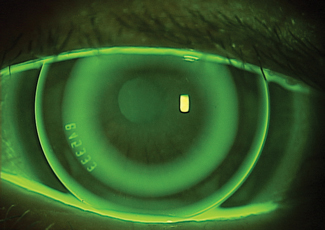 |
|
A smaller back optic zone diameter was able to improve myopia control efficacy within one year. Photo: Robert Ensley, OD, and Heidi Miller, OD. Click image to enlarge. |
Orthokeratology (ortho-K) is enjoying a bit of a renaissance as myopia control gains stature as a viable intervention for slowing progression in children. With this newfound interest comes new research and new insights. Many believe that the relative corneal refractive power of the apex induced by central corneal flattening and midperipheral corneal steepening can be used to indicate the extent of myopic defocus induced on the peripheral retina. A larger pupil size that allows more of the corneal annular steepened zone to fall within the pupil margin yields more relative peripheral myopic defocus and positive higher-order aberrations (HOAs) following ortho-K treatment, thereby driving greater myopia control efficacy.
Researchers recently suggested that modifying the ortho-K lens should aim to change the relative corneal refractive power or HOAs to benefit myopia management. They determined that ortho-K lenses designed with smaller back optic zone diameters (BOZD) increased myopia control efficacy, induced a steeper distribution of the relative corneal refractive power profile within the pupillary diameter and induced greater increases in total corneal HOAs and horizontal coma.
The study fit 102 children aged eight to 11 with 5.0mm- (group A) or 6.2mm-BOZD (group B) ortho-K lenses. Axial length (AL) and corneal topography were measured at baseline and during the annual visit. Relative corneal refractive power and corneal HOAs were compared between the two groups after one year of treatment. Multivariate linear regression analysis was performed to determine the association between AL elongation and relative corneal refractive power parameters, corneal HOAs and other variables between the groups.
After one year of treatment, axial elongation was slower in group A than in group B, with a difference of 0.15mm. Children in group A showed smaller treatment zone size, smaller 3/4X value (the distance from the apex relative corneal refractive power profile rising to its three-quarter peak level), greater relative corneal refractive power sum value within the pupillary area and higher increases in total corneal HOAs and horizontal coma. AL elongation was significantly correlated with baseline age, baseline spherical equivalent refraction, treatment zone size and 3/4X value.
“More complex lens design changes, such as decreasing BOZD or changing back optic zone asphericity, which lead to an relative corneal refractive power profile within the pupillary area rising to its three-quarter peak level at a smaller distance from the apex, may be considered to enhance myopia control efficacy in younger children or fast progressors,” the authors concluded in their paper.
Li N, Lin W, Zhang K, et al. The effect of back optic zone diameter on relative corneal refractive power distribution and corneal higher-order aberrations in orthokeratology. Cont Lens Anterior Eye. September 7, 2022. [Epub ahead of print]. |


